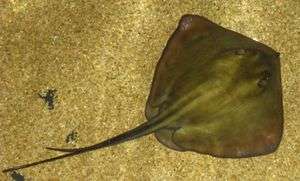Stingray injury
Background
- Stinger punctures skin to introduce heat-labile venom
- Generally causes local symptoms without systemic effects
- Often occurs when swimmers accidentally step on stingray in shallow water. Can be avoided by shuffling feet along bottom.

Common stingray (Dasyatis pastinaca)

A stingray's stinger (ruler in cm)
Clinical Features
- Symptoms can vary by species
- Associated with puncture or jagged laceration
- Local pain, irritation, erythema
- Systemic symptoms can include vomiting, muscle cramps, hypotension, paralysis, cardiac arrest
Differential Diagnosis
Marine toxins and envenomations
- Toxins
- Stingers
- Venomous fish (catfish, zebrafish, scorpion fish, stonefish)
- Cone shells
- Lionfish
- Sea urchins
- Nematocysts
- Coral reef
- Fire coral
- Jellyfish (Cnidaria)
- Portuguese man-of-war
- Sea anemones
- Phylum porifera (sponges)
- Bites
Evaluation
- Clinical diagnosis
- Consider x-ray to evaluate for retained foreign body (stinger)
Management
- Immediately immerse wound in hot water (45°C for 30-90min) [1]
- Supportive care
- Remove spines and stinger, if visible
- XR for evaluation of foreign bodies
- Tetanus prophylaxis
- Prophylactic antibiotics are controversial - if used, give ciprofloxacin to cover Vibrio vulnificus
Disposition
- Discharge
See Also
External Links
References
- Atkinson PRT. Is hot water immersion an effective treatment for marine envenomation? Emergency Medicine Journal. 2006;23(7):503–508. doi:10.1136/emj.2005.028456.
This article is issued from
Wikem.
The text is licensed under Creative
Commons - Attribution - Sharealike.
Additional terms may apply for the media files.